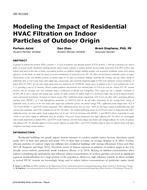Description
Exposure to ambient fine particles (PM2.5: particles less than 2.5 μm in diameter) and ultrafine particles (UFPs: particles less than 100 nm in diameter) has adverse effects on human health. Residential buildings greatly impact human exposure to outdoor particles because people spend more than 90% of their time indoors (and much of that time at home), and outdoor particles can infiltrate through building envelopes and mechanical ventilation systems with varying efficiencies. In this work, we model the impact of various combinations of central forced air HVAC filters and mechanical ventilation systems on indoor concentrations of fine and ultrafine particles of outdoor origin in six types of residential buildings including old, existing, and new homes relying on infiltration alone as well as new homes with supply-only, exhaust-only, and central-fan-integrated-supply (CFIS) with continuous exhaust ventilation. A typical 2025 ft² (188.1 m²) one-story single-family home was modeled in all ASHRAE climate zones in addition to the 15 most polluted cities in the U.S., providing a total of 22 locations. Hourly outdoor pollutant concentrations were obtained from US EPA for each site. Hourly HVAC runtime fractions and air exchange rates were estimated using a combination of BEopt and EnergyPlus. These inputs fed into a dynamic simulation in MATLAB to solve a discrete time-varying mass balance on indoor particles of outdoor origin in a well-mixed single zone based on physical particle source and removal mechanisms. Estimates of annual average PM2.5 infiltration factors ranged from ~0.4 to 0.2, for filters with a minimum efficiency reporting value (MERV) of 5 and high-efficiency particulate air (HEPA) filter in the old homes respectively. In the existing homes relying on infiltration alone, as well as in the new homes with supply-only ventilation systems, the annual average PM2.5 infiltration factor ranged from ~0.2 to ~0.15 with MERV 5 and HEPA filters respectively. PM2.5 infiltration factors were less than ~0.05 for new homes relying on infiltration only, with exhaust-only ventilation, and CFIS ventilation for all HVAC filters. The modeled infiltration factors for UFPs were lower in comparison with PM2.5 infiltration factors, but with similar trends ranging from ~0.22 and ~0.15 for old homes with MERV 5 and HEPA filters, respectively, to under ~0.02 in new homes relying on infiltration alone for all filters. These data clearly demonstrate that higher-efficiency HVAC filters can meaningfully reduce indoor proportions of outdoor PM2.5 and UFPs inside residences, but both home vintage and climate zone strongly influence the results. In general, high efficiency HVAC filtration appears to have a greater influence on indoor PM2.5 and UFPs of outdoor origin in older, less efficient homes with lower airtightness and longer system runtimes.
Citation: 2016 Winter Conference, Orlando, FL, Conference Papers
Product Details
- Published:
- 2016
- Number of Pages:
- 8
- Units of Measure:
- Dual
- File Size:
- 1 file , 1.7 MB
- Product Code(s):
- D-OR-16-C024




